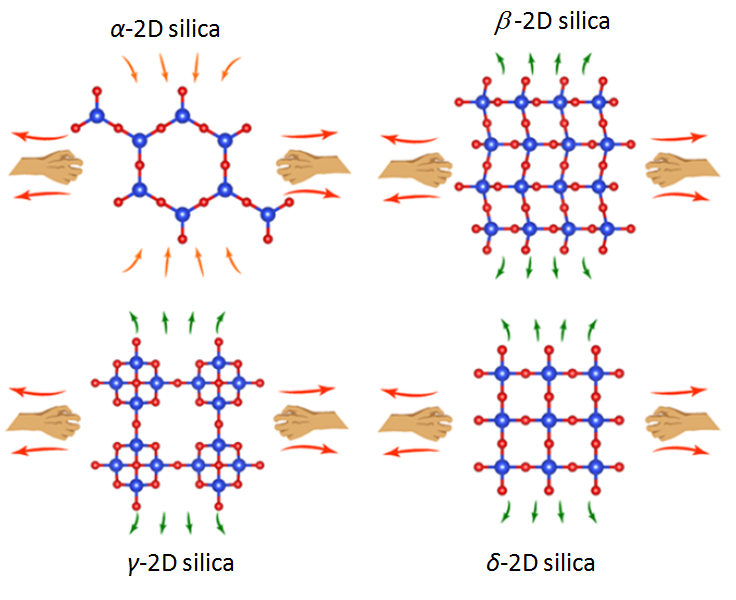Exotic two dimensional silica – Dr. Xiao Dong
JANUARY 31, 2017
Using computer modeling, scientists from HPSTAR and Tongji University have found out three new forms of 2D-silica with exotic mechanical and electrical properties — large negative Poisson’s ratios and widest electric bandgap among all reported 2D materials . They detailed their work in the latest issue of the journal Nano Letters (DOI: 10.1021/acs.nanolett.6b03921).
Silicon dioxide is the fundamental component of glass, sand and most minerals, which is also known as one of the building units of earth crust and mantle. There are a large number of polymorphs of silica in crystalline and amorphous forms, such as quartz, and glassy SiO2. It is well known that bulk silicon dioxide is a good insulator and building materials. What about two-dimensional (2D) silicon dioxide — a layered polymorph of silicon dioxide? Will the low dimentional structural silica show novel phenomenon? These are the focus of the present work.
A team co-led by Dr. Xiao Dong, a scientist of HPSTAR, use ab initio evolutionary algorithm for crystal structure and compound prediction -- USPEX (Universal Structure Predictor: Evolutionary Xtallography) to predict intrinsic mechanical and electronic porperties of 2D crystalline freestanding silicon dioxide.
They discovered three more new 2D-silica structures in their simulations. The three new 2D-silica display comparable thermal, dynamical and mechanical properties- superhardness, wide band gap - refers to the lowest energy of light that a semiconductor can absorb and a fundamental parameter required for controlling light receiving, conversion, and transport technologies, with many typical bulk forms of silica.
What surprised the scientists most is that all the three 2D silica have large inplane negative Poisson’s ratios with the largest one being double of penta-graphene and three times of borophenes.
Usually when a material is stretched in one direction, it usually contracts in the other two directions, are said to have a positive Poisson's ratio which characterizes how a material behaves when stretched. However, some materials becoming fatter when stretched, which means they have negative Poisson’s ratio.
 "A negative Poisson's ratio is theoretically possible long ago. While Two-dimensional (2D) materials- single-layer graphene, single-layer graphene ribbons, single-layer black phosphorus, cubic metals and α-Cristobalite, changed the case in their single layer structure,” said Dr. Xiao Dong.
"A negative Poisson's ratio is theoretically possible long ago. While Two-dimensional (2D) materials- single-layer graphene, single-layer graphene ribbons, single-layer black phosphorus, cubic metals and α-Cristobalite, changed the case in their single layer structure,” said Dr. Xiao Dong.
“This surprising negative Poisson’s ratio in 2D-silica originates from the interplay of lattice symmetry and Si-O tetrahedron symmetry” explained Dr. Xiao Dong.
Furthermore, they pointed out that 2D-silica are the most insulating 2D material among reported 2D structures with the widest gap.
These exotic 2D silica with negative Poisson’s ratios and widest band gaps are expected to have great potential applications in nanomechanics and nanoelectronics.
Caption:α-2D silica with positive Posson's ratio (up left), β-2D silica, γ-2D silica, and δ-2D silica with large in-plane negative Poisson’s ratios
SiO2是我们日常生活中最常见的材料,也是人类从石器时代开始使用的使用时间最长的材料。其中SiO2的一个最主要应用为作为电容器中的介电材料。而经典电子学告诉我们,电介质越薄其电容就越大。因为对只有几个原子层厚度的二维SiO2材料的研究就具有重要意义。董校领导的团队通过遗传算法预测了三种新型准二维的SiO2结构。计算发现他们都具有负泊松比的特殊性质。理论上分析负泊松比来源是三维的结构化学规律在低维条件下被破坏。即证明这三种新型的二维SiO2材料的负泊松比来源是低维效应。除此之外,我们还发现二维的二氧化硅具有所有已发现二维材料中最大的能隙,同时还要薄于其他准二维材料。因为材料的透光性与材料的厚度和能隙具有很大关系。二维二氧化硅可以认为是实际上已知的最透明材料。二维二氧化硅将在纳米力学和纳米电子学方面具有重要的潜在应用价值。
